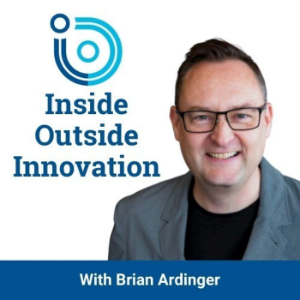
Inside Outside Innovation
Business & Economics Podcasts
Inside Outside Innovation explores the ins and outs of innovation with raw stories, real insights, and tactical advice from the best and brightest in startups & corporate innovation. Each week we bring you the latest thinking on talent, technology, and the future of innovation. Join our community of movers, shakers, makers, founders, builders, and creators to help speed up your knowledge, skills, and network. Previous guests include thought leaders such as Brad Feld, Arlan Hamilton, Jason Calacanis, David Bland, Janice Fraser, and Diana Kander, plus insights from amazing companies including Nike, Cisco, ExxonMobil, Gatorade, Orlando Magic, GE, Samsung, and others. This podcast is available on all podcast platforms and InsideOutside.io. Sign up for the weekly innovation newsletter at http://bit.ly/ionewsletter. Follow Brian on Twitter at @ardinger or @theiopodcast or Email brian@insideoutside.io
Location:
United States
Description:
Inside Outside Innovation explores the ins and outs of innovation with raw stories, real insights, and tactical advice from the best and brightest in startups & corporate innovation. Each week we bring you the latest thinking on talent, technology, and the future of innovation. Join our community of movers, shakers, makers, founders, builders, and creators to help speed up your knowledge, skills, and network. Previous guests include thought leaders such as Brad Feld, Arlan Hamilton, Jason Calacanis, David Bland, Janice Fraser, and Diana Kander, plus insights from amazing companies including Nike, Cisco, ExxonMobil, Gatorade, Orlando Magic, GE, Samsung, and others. This podcast is available on all podcast platforms and InsideOutside.io. Sign up for the weekly innovation newsletter at http://bit.ly/ionewsletter. Follow Brian on Twitter at @ardinger or @theiopodcast or Email brian@insideoutside.io
Language:
English
Divergent Thinking, College Towns & AI Poison with Brian Ardinger and Robyn Bolton
Duration:00:16:03
Hiring, Growth, Sameness, and Fridge Ads with Brian Ardinger and Robyn Bolton
Duration:00:17:56
Robots, Revivals, AI Slop, and the Bolt Conference with Brian Ardinger and Robyn Bolton
Duration:00:17:45
Why Startups Fail & Where Innovators Thrive with Brian Ardinger and Robyn Bolton
Duration:00:22:45
Corporate Innovation Tactics: When to Cut, Cull, and Create with Brian Ardinger and Robyn Bolton
Duration:00:18:42
Handwriting, Hype & The Future of Innovation with Ardinger and Bolton
Duration:00:20:36
Lead, Align, and Build what matters with Radhika Dutt, Author of Escaping the Performance Trap
Duration:00:23:18
Product Design Empathy and Context with Wayne Li, GA Tech Professor and Author
Duration:00:25:21
50 Ideas that Changed the World of Work with Jeremy Kourdi and Jonathan Besser
Duration:00:21:30
Innovator's Journey and Mapping your Progress with Robyn Bolton, founder of Mile Zero and author of Unlocking Innovation
Duration:00:20:39
Duncan Wardle, Disney's Head of Innovation and Creativity & Author of The Imagination Emporium
Duration:00:22:24
Immigration's Importance for the Innovation Economy with Dave Brown, founder of Brown Immigration
Duration:00:19:15
Shifting landscape of global talent with John Winsor, Open Assembly CEO
Duration:00:22:23
The Entrepreneurial Journey with Maria Flynn, Author of Make Opportunity Happen
Duration:00:19:12
AI, VC, & Data Insights into Corporate Innovation with Thomas Thurston of Ducera Partners
Duration:00:27:55
Pitfalls and Practicalities of Corporate Innovation with Elliott Parker, High Alpha Innovation CEO and Author of The Illusion of Innovation
Duration:00:17:51
Identifying and supporting Intrapreneurs with Louis Gump, Author of The Inside Innovator
Duration:00:20:48
E-commerce, Supply Chain, and Logistics with Paul Jarrett, Cofounder of Bulu
Duration:00:29:47
Corporate Innovation in Uncertain Times with Lisa Lutoff-Perlo, Celebrity Cruises CEO
Duration:00:19:30
Shadow Design Teams with Audrey Crane, Partner at DesignMap
Duration:00:18:18